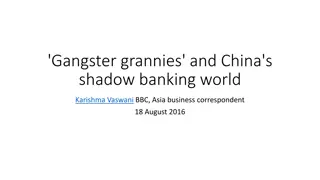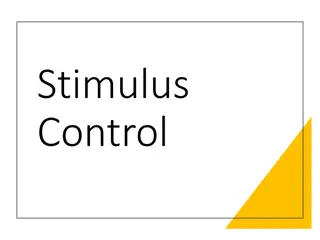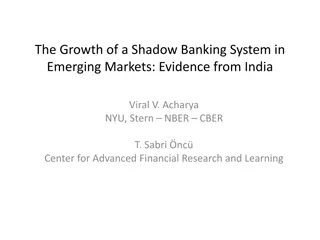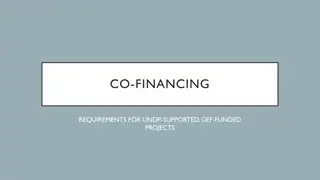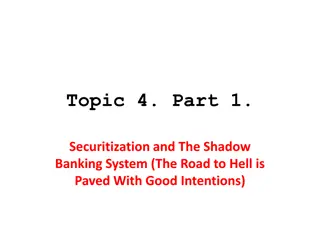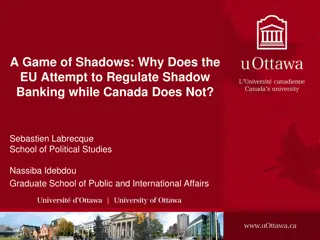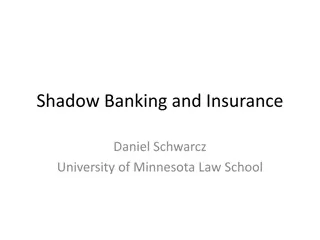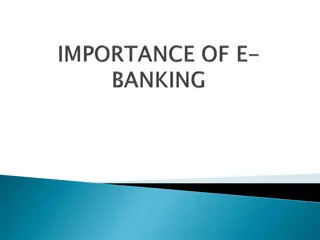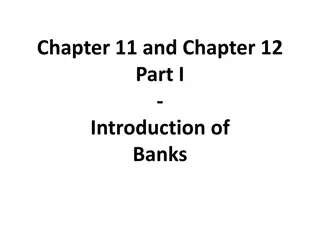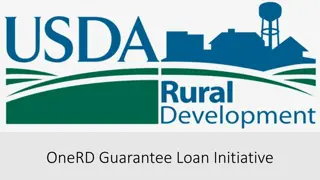The Financing of Local Government in China: Stimulus Loan Trends and Shadow Banking Growth
This paper examines the financing of local government in China, focusing on the transition from bank loans to non-bank debt, particularly the upsurge of shadow banking from 2012 onwards. It explores the reasons behind the rapid growth of shadow banking activities in China, including the impact of the 2009 stimulus and the marketization process of the Chinese financial system starting in 2012. The analysis reflects on the Four-Trillion Stimulus Plan announced in response to the 2007/08 global crisis and the financing mechanisms involved.
Download Presentation

Please find below an Image/Link to download the presentation.
The content on the website is provided AS IS for your information and personal use only. It may not be sold, licensed, or shared on other websites without obtaining consent from the author. Download presentation by click this link. If you encounter any issues during the download, it is possible that the publisher has removed the file from their server.
E N D
Presentation Transcript
THE FINANCING OF LOCAL THE FINANCING OF LOCAL GOVERNMENT IN CHINA: GOVERNMENT IN CHINA: STIMULUS LOAN WANES AND STIMULUS LOAN WANES AND SHADOW BANKING WAXES SHADOW BANKING WAXES ZHIGUO HE ( ) UNIVERSITY OF CHICAGO, BOOTH SCHOOL OF BUSINESS; AND NBER JOINT WITH ZHUO CHEN (TSINGHUA PBCSF) AND CHUN LIU (TSINGHUA SEM)
MOTIVATION Trust/Entrusted loans : ; WMP: Data source: PBOC and China Banking Wealth Management Registration System
NEW BANK LOAN & GDP New Bank Loan as a Percentage of 2004 GDP 55.0% 50.0 50.0% 45.0 45.0% 40.0 New Bank Loan/GDP 40.0% 35.0 35.0% GDP 30.0% 30.0 25.0% 25.0 20.0% 20.0 15.0% 10.0% 15.0 2004200520062007200820092010201120122013201420152016 New Bank Loan/2004 GDP GDP (2004 trillion RMB) Data source: PBOC and National Bureau of Statistics
US-CHINA BOND MARKETS Panel A: 2008-2017 Outstanding Bond Balance in China (in Trillions RMB) Bond/GDP~85% 80 70 25.05% 60 27.65% 50 17.40% 16.20% 29.55% 40 13.46% 30 31.14% 29.10% 8.47% 27.31% 57.55% 20 6.07% 56.15% 23.08% 5.99% 20.33% 57.00% 60.39% 10 64.83% 66.70% 72.21% 75.59% 78.64% 84.70% 0 2008 2009 2010 2011 2012 2013 2014 2015 2016 2017 Government Bonds Financial Bonds Corporate Bonds Panel B: 2008-2017 Outstanding Bond Balance in US (in Trillions $) Bond/GDP~200% 35 30 20.14% 19.21% 18.71% 17.37% 16.41% 25 14.63% 13.31% 12.71% 15.92% 16.42% 9.92% 17.07% 18.62% 7.46% 19.38% 20 21.07% 22.93% 25.00% 29.34% 33.91% 15 63.94% 10 64.38% 64.22% 64.01% 64.21% 64.30% 63.76% 62.29% 60.74% 58.63% 5 0 2008 2009 2010 2011 2012 2013 2014 2015 2016 2017 Government Bonds Financial Bonds Corporate Bonds
SUMMARY CHINA S LOCAL GOVERNMENT DEBT SHIFTS FROM BANK LOANS IN 2009 TO A SIGNIFICANT FRACTION OF NON-BANK DEBT STARTING 2012 THIS PAPER: THE REAL FORCE BEHIND THE UPSURGE OF SHADOW BANKING A universal economic phenomenon/mechanism WHY DO SHADOW BANKING ACTIVITIES IN CHINA START RAMPANT GROWTH AROUND 2012-13? Hangover effect of 2009 stimulus Time series and cross-section evidence on local government financingand municipal corporate bonds ( ) An angle that helps understand the marketization process of Chinese financial system starting 2012
FOUR-TRILLION STIMULUS PLAN AND ITS FINANCING FOUR-TRILLION STIMULUS PLAN ( ) Following 2007/08 global crisis, Premier Wen announced the 4T RMB stimulus plan on Nov 2008 Domestic investment (mainly infrastructure) to boost GDP growth HOW WAS IT IMPLEMENTED AND FINANCED? Mostly through local governments (Bai, Hsieh and Song, 2016, Brookings) 1 trillion from Beijing; the rest through LGFV (Local Government Financing Vehicles, ) Mostly in the form of bank loans (90% commercial bank loans and 10% policy bank loans)
FOUR-TRILLION STIMULUS PLAN AND ITS FINANCING Transfer of 1 Trillion RMB Beijing, central govt Local Government 1994 Budget law Equity holder, by injecting land Commercial Banking system Local Government Financing Vehicle (Local State-Owned Enterprises) Loans of 2.7 Trillion RMB Households deposits Loans of 0.3 Trillion RMB Policy Banks
SHIFTING OF LOCAL GOVERNMENT FINANCING (1) IN 2010 CHINA REVERTED BACK TO ITS NORMAL CREDIT POLICY 2009 STIMULUS LOAN HANGOVER EFFECT Need to rollover/refinance their three- to five-year bank loans (which are maturing around 2012 to 2014) Long-term infrastructure projects need continuing investment LGFVS TURN TO NON-BANK SOURCES What are they?
SHIFTING OF LOCAL GOVERNMENT FINANCING (2) FOUR MAJOR DEBT LIABILITIES Bank Loans Municipal Bonds ( : pre-2015, issued directly by MoF for qualified local government; post-2015, issued by local government at the province level) Municipal Corporate Bonds ( , our focus) Corporate bonds issued by LGFVs Trust and Entrusted Loans ( ) OTHER THREE ARE NON-BANK DEBT; OFTEN WITH IMPLICIT BAIL-OUT EXPECTATION NATIONAL AUDIT OFFICE REPORTS ON LOCAL GOVERNMENT DEBT, ON DEC 2010 AND JUNE 2013 Worked hard filling out the rest Bank loan wanes, non-bank debt waxes
COMPOSITION CHANGE OF BANK AND NON-BANK DEBT FINANCING Composition of local government debt balance, percentage 100% Bank Loan Munibond+MCB+Trust NAO MCB 80% Percentage (%) NAO 60% 40% 20% 0% Dec-08 Dec-09 Dec-10 Dec-11 Dec-12 Dec-13 Dec-14 Dec-15 Dec-16
MUNICIPAL CORPORATE BOND MCB, Newly Issued Municipal Corporate Bonds (MCB) 30.0% 3.5% 3.0% 25.0% 2.5% New Bank Loan/GDP 20.0% New MCB/GDP 2.0% 15.0% 1.5% 10.0% 1.0% 5.0% 0.5% 0.0% 0.0% 2004200520062007200820092010201120122013201420152016 Bankloan/GDP MCB_all/GDP MCB_net/GDP Data source: PBOC and Wind
CROSS-SECTIONAL ANALYSES: EVIDENCE FROM MCB CORE IDEA Areas/provinces with more bank-loan-fueled stimulus in 2009 should have more shadow banking in 2012-2015 Matters little whether driven by LGFVs (demand) or banks (supply) in 2009 Though, we use late-term officials as IV (demand shifter) to address other endogeneity concerns WE FOCUS ON MUNICIPAL CORPORATE BONDS It is more than data availability issue; source of fund versus use of fund For MCB, we know where the funds go to
PRELIMINARY EVIDENCE ECONOMIC VARIABLES Abnormal 2009 Bank loan over GDP at the province level (BL/GDP at 2009) (Average BL/GDP 2004~08) Abnormal 201t MCB over GDP for each province over 2012-2015 (MCB/GDP at 201t) (Average MCB/GDP 2004~08) WE ALSO LOOK AT REGIONAL AND CITY LEVEL
PROVINCIAL EVIDENCE FOR EACH YEAR, 2012-2015
MAIN EMPIRICAL TESTS EMPIRICAL SPECIFICATION Province FE (??) and year FE (??); from 2004 to 2015 Time-varying impacts of 2009 abnormal BL on future MCB issuances Controls with flexible time coefficients: economic activity at 2007Q4-2008Q3 Fiscal deficit over GDP, fixed asset investment over GDP; GDP growth, GDP per capita Instrument variable: whether a provincial governor is late term (>2 years in the position) as of 2009 Stronger promotion incentive for late-term governor to react to the stimulus More familiar with the local environment, easier to implement the stimulus OTHER EVIDENCES The effect of longer-term CDB loans, city level results Control variables at the same year for omitted variables Real effects
OLS RESULT Throughout, standard errors clustered at province-year level
MCB ISSUANCE PURPOSES 81% of MCB prospectus reveal its purpose . but self-reporting Newly Issued Municipal Corporate Bonds (MCB) by Purposes 30.0% 1.4% 1.2% 25.0% New Bank Loan/GDP 1.0% New MCB/GDP 20.0% 0.8% 15.0% 0.6% 10.0% 0.4% 5.0% 0.2% 0.0% 0.0% 2004200520062007200820092010201120122013201420152016 New Bank Loan/GDP New MCB_repay/GDP New MCB_inv/GDP New MCB_other/GDP
ESTIMATION RESULTS MCB OLS -0.007 (0.017) -0.006 (0.017) -0.009 (0.016) -0.001 (0.014) 0.036*** (0.005) 0.037** (0.015) 0.075*** (0.018) 0.058 (0.066) 0.263*** (0.091) 0.382** (0.150) 0.37** (0.172) MCB_repay OLS -0.001 (0.005) -0.001 (0.005) -0.001 (0.005) -0.001 (0.005) 0.002 (0.004) 0.009 (0.006) 0.015*** (0.003) 0.020 (0.019) 0.091*** (0.034) 0.12** (0.049) 0.187*** (0.058) MCB_inv 2SLS 0.006 (0.038) 0.006 (0.038) 0.005 (0.039) 0.010 (0.034) 0.093*** (0.011) 0.126*** (0.027) 0.181*** (0.037) 0.075 (0.121) 0.392* (0.202) 0.694** (0.302) 0.958*** (0.317) 2SLS -0.001 (0.011) -0.001 (0.011) -0.001 (0.011) -0.001 (0.011) 0.001 (0.010) 0.019*** (0.007) 0.047*** (0.007) 0.012 (0.047) 0.120 (0.078) 0.201* (0.114) 0.473*** (0.120) OLS -0.006 (0.009) -0.006 (0.009) -0.009 (0.008) 0.003 (0.006) 0.030*** (0.007) 0.022* (0.013) 0.041*** (0.007) 0.002 (0.053) 0.098*** (0.030) 0.040 (0.054) -0.013 (0.057) 2SLS 0.005 (0.017) 0.005 (0.018) 0.005 (0.018) 0.017 (0.014) 0.079*** (0.022) 0.077*** (0.030) 0.060** (0.024) 0.065 (0.077) 0.162*** (0.054) 0.247*** (0.087) 0.115 (0.071) 2004 2005 2006 2007 2009 2010 2011 2012 2013 2014 2015 Province FE Year FE Control*Year Observations First stage F Adj R2 Yes Yes Yes 360 Yes Yes Yes 360 3.803 0.695 Yes Yes Yes 360 Yes Yes Yes 360 3.803 0.629 Yes Yes Yes 360 Yes Yes Yes 360 3.803 0.665 0.720 0.652 0.671
ECONOMIC MAGNITUDE WHAT IS THE LOAN MATURITY IMPLIED BY ESTIMATED COEFFICIENTS? IN AGGREGATE, EACH DOLLAR OF STIMULUS LOAN NEEDS 1.57/4.7 = 33 CENTS OF REPAYMENT MCB ISSUANCE RMB 4.7 trillion abnormal bank loans extended in 2009 In total, RMB 1.57 trillion worth of MCB was issued to repay bank loans (the rest is repaid by trust) CROSS-SECTIONAL REGRESSION, HOW MANY YEARS DO WE NEED TO PAYBACK 33 CENTS? Just accumulating the estimated coefficients . The IV estimate implied stimulus loan maturity is 3.9 years Consistent with other sources (3-5 years in Kroeber, 2016; 4.1 years in Ru, 2018)
EVIDENCE FROM CDB LOAN LOANS FROM CHINA DEVELOPMENT BANK HAVE LONGER MATURITY CDB: policy bank, tends to give longer maturity loans (7.2 years in Ru, 2018) ROLLOVER MECHANISM IS CONCENTRATED IN IN LOW-CDB-LOAN PROVINCES ???: whether the 2009 CDB loan fraction of a province i is below the Dummy ????,2009 median (max 74%, median 16%) PREDICTION ??BL which captures the effect on high CDB-loan province should be insignificant The coefficients ??inter in front of the interaction term have similar magnitude as the baseline without CDB interactions
EVIDENCE AT CITY LEVEL MCB OLS 2SLS MCB_repay OLS MCB_inv OLS 2SLS 2SLS 2004 -0.002 (0.004) -0.001 (0.004) -0.002 (0.004) 0.000 (0.004) 0.005* (0.003) 0.009*** (0.002) 0.017*** (0.002) 0.065** (0.027) 0.065*** (0.017) 0.142*** (0.034) 0.091** (0.038) -0.001 (0.010) 0.000 (0.010) 0.000 (0.010) 0.004 (0.009) 0.032*** (0.003) 0.024*** (0.003) 0.007 (0.009) 0.084* (0.046) 0.111** (0.047) 0.303*** (0.088) 0.341*** (0.083) 0.000 (0.000) 0.000 (0.000) 0.000 (0.000) 0.000 (0.000) 0.000 (0.001) 0.001 (0.001) 0.004*** (0.001) 0.020** (0.008) 0.022** (0.009) 0.061*** (0.014) 0.070*** (0.012) 0.000 (0.000) 0.000 (0.000) 0.000 (0.000) 0.000 (0.000) 0.000 (0.003) 0.003 (0.002) 0.011*** (0.002) 0.034*** (0.012) 0.047*** (0.014) 0.112*** (0.033) 0.176*** (0.035) -0.002 (0.001) -0.001 (0.002) -0.002 (0.001) 0.000 (0.001) 0.005*** (0.002) 0.007*** (0.002) 0.0101** (0.005) 0.028*** (0.005) 0.014** (0.006) 0.025*** (0.007) 0.010*** (0.004) 0.000 (0.005) 0.000 (0.005) 0.001 (0.005) 0.005 (0.004) 0.028*** (0.006) 0.009 (0.010) -0.009 (0.011) 0.026 (0.026) 0.014 (0.021) 0.191*** (0.025) 0.078*** (0.018) 2005 2006 2007 2009 2010 2011 2012 2013 2014 2015 City FE Year FE Control*Year Observations First-stage effective F Adj R2 Yes Yes Yes 3,900 Yes Yes Yes 3,648 Yes Yes Yes 3,900 Yes Yes Yes 3,648 Yes Yes Yes 3,900 Yes Yes Yes 3,648 5.426 5.426 5.426 0.394 0.357 0.346 0.273 0.235 0.235
LINK TO SHADOW BANKING Local Government Non-Bank Debt over Shadow Banking 50.0% 40.0% 30.0% 20.0% 10.0% 0.0% Dec-08 Dec-09 Dec-10 Dec-11 Dec-12 Dec-13 Dec-14 Dec-15 Dec-16
LINK TO SHADOW BANKING: ENTRUSTED LOAN GROWTH Entrusted Loan/GDP_2009 on 2009 Abnormal Bank Loan/GDP 2013 EL/GDP_2009 2014 EL/GDP_2009 2015 EL/GDP_2009 OLS 2SLS OLS 2SLS OLS 2SLS 2009 BL/GDP 0.294* 0.473 0.468*** 0.363 -0.0756 0.326 (1.876) (1.436) (2.953) (0.697) (-0.282) (0.856) Control Yes Yes Yes Yes Yes Yes Observations 30 30 30 30 30 30 Adj. R2 0.256 0.220 0.293 0.284 0.219 0.109 Unfortunately, province-level EL data are only available after 2013 In 2015, tightening regulation on Trust/Entrusted business in China Placebo: Abnormal Bank Loan/GDP_2009 on 2009 Abnormal Bank Loan/GDP 2013 Abnormal BL/GDP 2014 Abnormal BL/GDP 2015 Abnormal BL/GDP OLS 2SLS OLS 2SLS OLS 2SLS 2009 BL/GDP -0.0809 -0.338 -0.152 -0.133 -0.284 -0.851 (-0.400) (-0.798) (-0.626) (-0.257) (-0.655) (-1.093) Control Yes Yes Yes Yes Yes Yes Observations 30 30 30 30 30 30 Adj. R2 0.565 0.553 0.644 0.644 0.486 0.460
LINK TO SHADOW BANKING: WEALTH MANAGEMENT PRODUCT 7.0 6.0 5.0 61.5%, 4.19 Trillion RMB 4.0 3.0 42.5%, 2.21 38.9%, 1.57 2.0 1.0 0.0 Dec-14 Dec-15 Dec-16 AAA by WMP AA+ by WMP AA by WMP Total MCB AA- by WMP Based on annual official reports on WMP; likely underestimate as unclear whether including certain financial innovation funded through WMP
US EXPERIENCE IN NATIONAL BANKING ERA CHINA S SHADOW BANKING IN TODAY HAS STRIKING SIMILARITY WITH THE US HISTORY NATIONAL BANKING ERA (1863-1912) IN US Started with the passage of national banking act (1864) which ended the free banking era Tightly regulated nationally chartered banks, segmented Frequent banking panics, especially the 1907 panic triggered by a run on Trust companies, led to Fed as the Central Bank in US ECONOMIC BACKGROUND Industrial revolution in the Northeast to the settlement of the West; railroad construction in US is like infrastructure in China today A new industry craving for financing, but national banks cannot REGULATORY ARBITRAGE (LIKE IN CHINA) States in the west started imposing less restrictive regulations, so-called state banks Trust companies, which are state-chartered financial institutions
TRUST COMPANIES IN US HISTORY TRUST COMPANIES ACCORDING TO CAROSSO (1970, P. 99) Incorporated under liberal state laws, trust companies quickly extended their activities far beyond those usually associated with the services of a fiduciary institution. Beginning in the 1890s, trust companies took on most of the functions of both commercial and private banks. They accepted deposits; made loans; participated extensively in reorganizing railroads and consolidating industrial corporations; acted as trustees, underwriters, and distributors of new securities; and served as depositories of stocks, bonds, and titles ..... Very often they also owned and managed real estate. THIS IS ESSENTIALLY WHAT CHINA S TRUST COMPANIES DO
WHAT DO WE LEARN? NEAL (1971): TRUST COMPANIES IN US HISTORY Invested in new industrial securities on the asset side, and issued deposit to expand the money supply Helped establish a financial market to feed real economy Form money trust with other dominating commercial banks at that time IN CHINA, SHADOW BANKING Supports infrastructure, real estate, and private firms while generating a savings vehicle (WMP) for Chinese households Accelerates the growth of Chinese corporate bond market at an astonishing speed (Amsted and He, 2018) Relies on the retail network of existing banking branch system; the shadow of banks
DEVELOPMENT OF CORPORATE BOND MARKETS IN CHINA
CONCLUSION A MECHANISM THAT PUTS TOGETHER RECENT VARIOUS ASPECTS OF CHINA S FINANCIAL MARKET Local government debt; shadow banking; interest rate liberalization SHADOW BANKING: UNINTENDED CONSEQUENCE OF FOUR-TRILLION STIMULUS PLAN Good? bad? Popular view: hidden risk and leverage, so bad BUT IT FOSTERS THE MODERNIZATION OF CHINA S FINANCIAL MARKETS Let market be decisive; interest rate liberalization and deposit insurance Rocket-speed of the growth of interbank market in China; less reliance on commercial banks; richer set of investment products Chen, Chen, He, Liu, and Xie (2019) on pledgeability effect Households get the return they ought to get (not just house price appreciation)
HALF OF 2009 ABNORMAL BANK LOANS GO TO LGFV Data source: Authors estimate and Gao et al. (2018)
PANEL REGRESSIONS WITH SIMULTANEOUS CONTROLS MCB OLS 2SLS 2004 -0.001 -0.038 (0.026) (0.061) 2005 0.024 -0.003 (0.022) (0.053) 2006 0.008 -0.014 (0.019) (0.039) 2007 0.004 -0.005 (0.016) (0.039) 2009 -0.006 -0.002 (0.025) (0.060) 2010 -0.039 -0.014 (0.053) (0.098) 2011 0.012 0.040 (0.066) (0.126) 2012 0.112 0.284 (0.097) (0.177) 2013 0.187** 0.191* (0.078) (0.104) 2014 0.359*** 0.454*** (0.101) (0.137) 2015 0.252** 0.269 (0.128) (0.169) Province FE Yes Yes Year FE Yes Yes Control Yes Yes Observations 360 360 Adj R2 0.743 0.721 MCB_repay OLS 0.014 (0.011) 0.0194* (0.010) 0.014 (0.009) 0.006 (0.007) -0.008 (0.009) -0.019 (0.022) -0.005 (0.030) 0.032 (0.027) 0.089*** (0.031) 0.143*** (0.040) 0.134*** (0.052) Yes Yes Yes 360 0.660 MCB_inv OLS -0.019*** (0.006) -0.006 (0.007) -0.013** (0.005) -0.005 (0.008) 0.001 (0.013) -0.011 (0.020) 0.003 (0.019) -0.013 (0.033) 0.047** (0.021) 0.048 (0.032) -0.013 (0.031) Yes Yes Yes 360 0.673 2SLS 0.013 (0.019) 0.018 (0.017) 0.012 (0.012) 0.007 (0.011) -0.008 (0.019) -0.023 (0.041) 0.002 (0.056) 0.076 (0.064) 0.123** (0.059) 0.213*** (0.075) 0.139** (0.060) Yes Yes Yes 360 0.635 2SLS -0.045* (0.023) -0.027 (0.021) -0.029** (0.015) -0.014 (0.018) -0.007 (0.027) 0.004 (0.038) -0.009 (0.039) 0.014 (0.056) 0.019 (0.034) 0.133** (0.057) 0.044 (0.043) Yes Yes Yes 360 0.680
EVIDENCE FROM CDB LOAN CDB is a policy bank and thus usually its loan has longer maturity Less rollover pressure for provinces with more CDB LGFV loan received in 2009 MCB MCB_repay OLS -0.001 (0.006) -0.001 (0.006) -0.001 (0.006) -0.001 (0.006) 0.008 (0.006) 0.020*** (0.007) 0.028*** (0.007) 0.090 (0.064) 0.180*** (0.066) 0.225*** (0.074) 0.382*** (0.069) 0.000 (0.005) -0.005 (0.005) -0.065 (0.063) Yes Yes Yes Yes 360 0.730 MCB_inv OLS -0.002 (0.011) -0.002 (0.011) -0.003 (0.011) 0.005 (0.011) 0.065*** (0.015) 0.061*** (0.018) 0.060*** (0.018) 0.216*** (0.075) 0.274*** (0.073) 0.256*** (0.078) 0.212*** (0.071) -0.004 (0.011) -0.014 (0.015) -0.146* (0.075) Yes Yes Yes Yes 360 0.711 OLS -0.002 (0.015) -0.002 (0.016) -0.003 (0.016) 0.002 (0.016) 0.086*** (0.017) 0.099*** (0.024) 0.118*** (0.033) 0.408*** (0.142) 0.639*** (0.146) 0.858*** (0.156) 0.994*** (0.154) -0.004 (0.013) -0.024 (0.016) -0.281** (0.138) Yes Yes Yes Yes 360 0.810 2SLS 0.007 (0.069) 0.008 (0.069) 0.007 (0.069) 0.005 (0.072) 0.128*** (0.032) 0.204*** (0.045) 0.224*** (0.058) 0.255 (0.382) 0.612 (0.380) 1.064** (0.456) 1.326*** (0.463) -0.003 (0.079) -0.038 (0.034) -0.154 (0.454) Yes Yes Yes Yes 360 0.725 2SLS -0.001 (0.020) -0.001 (0.020) -0.001 (0.020) -0.001 (0.020) 0.010 (0.016) 0.025 (0.018) 0.058*** (0.016) -0.067 (0.156) 0.082 (0.155) 0.175 (0.182) 0.503*** (0.172) -0.001 (0.024) -0.005 (0.017) 0.085 (0.191) Yes Yes Yes Yes 360 0.664 2SLS 0.007 (0.035) 0.009 (0.035) 0.007 (0.034) 0.011 (0.034) 0.101** (0.034) 0.150*** (0.039) 0.080** (0.036) 0.150 (0.145) 0.205 (0.139) 0.251 (0.157) 0.134 (0.146) -0.003 (0.035) -0.031 (0.039) -0.022 (0.143) Yes Yes Yes Yes 360 0.655 Low CDB*2004 Low CDB*2005 Low CDB*2006 Low CDB*2007 Low CDB*2009 Low CDB*2010 Low CDB*2011 Low CDB*2012 Low CDB*2013 Low CDB*2014 Low CDB*2015 2004-2007 2009-2011 2012-2015 Low CDB*Year Province FE Year FE Control*Year Observations Adj R2
REAL EFFECTS OF STIMULUS LOANS GDP per capita/GDP per capita_2009 OLS 2SLS 2004 0.087 0.83*** (0.169) (0.195) 2005 -0.015 0.357* (0.169) (0.208) 2006 -0.049 0.200 (0.191) (0.204) 2007 -0.007 0.345 (0.108) (0.246) 2009 -0.088 0.454*** (0.057) (0.101) 2010 0.108 0.599*** (0.081) (0.210) 2011 0.346*** 0.938** (0.135) (0.435) 2012 0.394 1.67** (0.280) (0.722) 2013 0.393 2.725** (0.440) (1.208) 2014 0.379 3.892** (0.624) (1.716) 2015 0.397 5.169*** (0.724) (1.934) Province FE Yes Yes Year FE Yes Yes Control*Year Yes Yes Observations 360 360 Adj R2 0.979 0.982 FAI: fixed asset investment FAI/GDP_2009 OLS 0.136 (0.223) 0.035 (0.249) -0.030 (0.226) -0.095 (0.190) 0.444** (0.199) 0.776*** (0.227) 0.817*** (0.317) 0.815* (0.460) 0.980 (0.635) 0.793 (0.778) 1.753** (0.862) Yes Yes Yes 360 0.970 2SLS 0.657 (0.414) 0.341 (0.464) 0.108 (0.448) 0.031 (0.415) -0.067 (0.347) 0.437 (0.546) 0.040 (0.886) 0.164 (1.155) -0.205 (1.507) 0.166 (1.701) 4.596** (1.849) Yes Yes Yes 360 0.970


